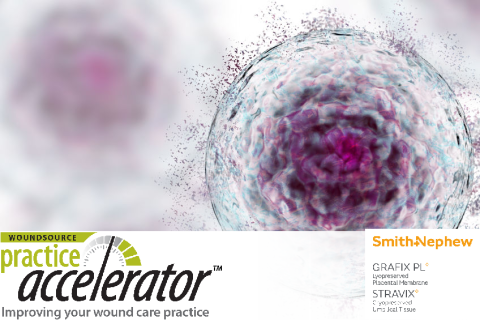Advanced Wound Care Interventions for Non-Healing Wounds
February 28, 2021
Chronic and non-healing wounds are those that do not progress through the healing process in a timely or predicted manner. They are a global problem and are becoming harder to treat. Medicare estimates that over 8 million Americans have chronic wounds that cost the national health care system between $18.1 and $96.8 billion dollars annually.1 Most wound care protocols recommend standard wound care treatments, including debridement when indicated, the application of dressings, and periodic reassessment. However, non-healing wounds often require advanced treatment to enable these wounds to progress through the stages of healing.
Management of the Wound Bed
During normal wound-healing, a balance of healthy proteins and enzymes promotes healing in the wound bed. Disruption to this balance can cause the wound to become chronic. Such disruption can take many forms, although a common type of disruption is elevated protease activity, which contributes to chronic inflammation. In addition, intrinsic factors, such as age and comorbidities, and extrinsic factors, such as lifestyle and polypharmacy, can impact the delicate chemical balance in the wound bed.2
How much do you know about complex wounds? Take our 10-question quiz to find out! Click here.
The first step for moving a chronic wound to an acute status is adequate wound bed preparation, which can be achieved with various strategies, including debridement, maintaining a proper moisture balance, and reducing the bacterial bioburden and inflammation.3 For non-healing diabetic foot and pressure injuries, offloading is also a crucial strategy. For venous ulcers, compression can be beneficial.2 The road to healing for many wounds starts with management of the wound bed. Moreover, the effectiveness of many advanced therapies relies on proper wound bed preparation that promotes healing.2 Even with the introduction of advanced wound therapies, including dressings, negative pressure wound therapy (NPWT), and cellular and/or tissue-based products, less than half of wounds heal after 12 weeks of treatment. However, the combination of proper wound bed preparation and advanced therapy can lead to greater success in helping these wounds achieve healing.3
Advanced Therapies for Non-Healing Wounds
Cellular and Tissue-Based Therapies This type of advanced therapy consists of several therapies based on cells, including3:
- Stem cells, including bone marrow stem cells, keratinocytes, and fibroblasts
- Scaffolds, including carrier systems
- Skin substitutes
- Tissue-based therapies, including autologous blood derivatives for wound care and advanced cell therapy
- Epidermal substitutes, dermal substitutes, and dermoepidermal substitutes
- Melanocytes, vessels, and genetic manipulation
Stem cells derived from a variety of sources induce immunomodulation in the wound bed and facilitate healing by resolving inflammation, thus making them attractive cell therapeutic agents to treat chronic wounds.4Negative Pressure Wound Therapy NPWT has been described as an effective treatment for wounds of many etiologies, including complex non-healing wounds.5 With NPWT, subatmospheric pressure is applied to the surface of a wound sealed off by a film dressing and connected to a suction pump and drainage collection system with a tube. The use of NPWT is becoming increasingly popular because it can reduce the number of dressing changes required. It can be readily applied at the bedside,6 and it can result in improved healing and better patient outcomes.7
Antimicrobial Dressings There are numerous innovative wound care dressings specifically developed to treat chronic wounds. These dressings contain a variety of antimicrobial agents, such as silver,2 polyhexamethylene biguanide, medical-grade honey, povidone-iodine, dialkylcarbamoyl chloride, and chlorhexidine gluconate.8 These dressings can work to manage bioburden levels in the wound and inhibit protease activity.2
Conclusion
Chronic wounds remain a significant challenge in clinical practice and can have a detrimental impact on patients’ quality of life. Understanding the biological processes occurring in the wound bed can help clinicians optimize these conditions and select compatible advanced therapies to overcome the challenges that delay healing of complex and chronic wounds.

References
- Nussbaum SR, Carter MJ, Fife CE, et al. (2018). An economic evaluation of the impact, cost, and Medicare policy implications of chronic on-healing wounds. Value Health. 2018;21:27-32.
- Chamanga ET. Clinical management of non-healing wounds. Nurs Stand. 2017;32(29):48-62.
- Armstrong DG, Bauer K, Bohn G, et al. Principles of best diagnostic practice in tissue repair and wound healing; an expert consensus. Diagnostics (Basel). 2020;11(1):50. https://doi.org/10.3390/diagnostics11010050. Accessed February 15, 2021.
- Nuschke A. Activity of mesenchymal stem cells in therapies for chronic skin wound healing. Organogenesis. 2014;10(1):29-37.
- Apelqvist J, Willy C, Fagerdahl A, et al. EWMA document: negative pressure wound therapy. J Wound Care. 2017;26(Suppl 3):S1-S154.
- Robert N. Negative pressure wound therapy in orthopaedic surgery. Orthop Traumatol Surg Res. 2017;103(1 Suppl):S99-S104.
- El-Sabbagh AH. Negative pressure wound therapy: an update. Chin J Traumatol. 2017;20(2):103-107.
- Mana TSC, Donskey C, Carty N, Perry L, Leaper D, Edmiston CD Jr. Preliminary analysis of the antimicrobial activity of a postoperative wound dressing containing chlorhexidine gluconate against methicillin-resistant Staphylococcus aureus in an in vivo porcine incision wound model. Am J Infect Control. 2019;47:1048-1052.
The views and opinions expressed in this blog are solely those of the author, and do not represent the views of WoundSource, HMP Global, its affiliates, or subsidiary companies.











